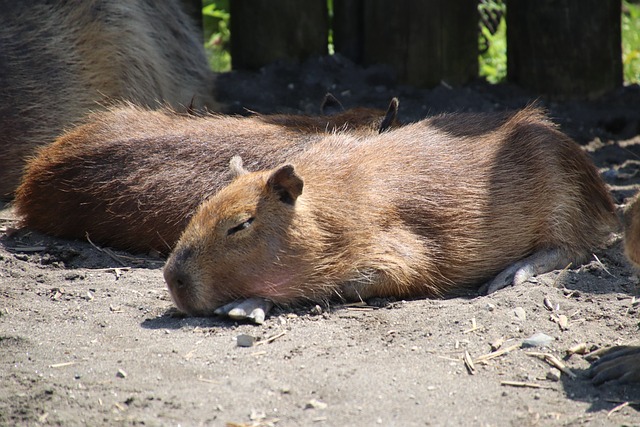Capybaras are generally peaceful animals and do not typically attack dogs. Capybaras are known to be quite social and are often seen interacting peacefully with other animals, including dogs.
However, like any wild animal, they may defend themselves if they feel threatened or cornered. It’s always best to exercise caution and respect wild animals’ space to prevent potential conflicts.
Dogs and Capybaras Interactions
Common Interaction Scenarios
Capybaras are generally peaceful animals and tend to avoid confrontations with other animals. However, they can become aggressive when they feel threatened, or their offspring are in danger.
Capybaras may sometimes attack dogs that come too close to their territory or their young.
One common scenario where capybaras and dogs may interact is in rural areas where both animals live in close proximity.
If a dog approaches a capybara’s territory, the capybara may become defensive and try to scare the dog away. If the dog persists, the capybara may attack the dog.
Another scenario where capybaras and dogs may interact is in urban areas where capybaras have been introduced as pets. In these cases, the capybaras may become more accustomed to dogs and less likely to attack them.
Factors Affecting Aggression
Several factors can affect the likelihood of a capybara attacking a dog.
One factor is the size of the dog. Capybaras are much larger than most dogs, and they may feel more threatened by smaller dogs.
Additionally, the breed of the dog can also play a role in the likelihood of an attack. Some breeds, such as hunting dogs, may be more likely to provoke a capybara than others.
Another factor that can affect the likelihood of an attack is the capybara’s environment.
Capybaras living in areas with a lot of human activity may be more accustomed to dogs and less likely to attack them. However, capybaras that live in more isolated areas may be more aggressive towards dogs.
Overall, while capybaras are generally peaceful animals, they can become aggressive when they feel threatened or when their offspring are in danger.
Dog owners should be cautious when approaching capybaras and keep their dogs on a leash in areas where capybaras are known to live.
Capybara Aggression Triggers
Capybaras are generally peaceful animals but may become aggressive in certain situations. Here are some common triggers that may cause capybaras to attack:
1. Threats to their young
Capybaras are very protective of their young and may attack if they feel their offspring are in danger. If a dog approaches a capybara and its young, the capybara may perceive the dog as a threat and attack to protect its young.
2. Provocation
Capybaras may become aggressive if they feel provoked. If a dog barks or growls at a capybara, the capybara may interpret this as a threat and attack in response.
3. Territory
Capybaras are territorial animals, and they may attack if they feel their territory is being invaded. If a dog enters a capybara’s territory, the capybara may see the dog as a threat and attack to defend its territory.
4. Hunger
Capybaras are herbivores, and they may become aggressive if they are hungry. In some cases, capybaras have been known to attack dogs near their food source.
It’s important to remember that capybaras are wild animals and should be treated with caution and respect. If you encounter a capybara in the wild, keeping a safe distance and avoiding provoking the animal is best.
Preventing Negative Encounters
Proper Socialization
Socialization is essential to any animal’s upbringing, and capybaras are no exception. Proper socialization can help prevent negative encounters with dogs and other animals.
Capybaras raised around dogs are generally more accepting of them and are less likely to see them as a threat.
It is recommended that capybara owners start socializing their pets with dogs at a young age to help them become accustomed to them.
Owners should supervise all interactions between their capybaras and dogs, especially in the beginning stages of socialization.
Safe Environment Creation
Creating a safe environment for capybaras and dogs is crucial to prevent negative encounters. Capybaras require a lot of space to roam and explore and access water to swim and cool off.
Owners should ensure that their capybaras have plenty of space and access to water to prevent them from feeling threatened or cornered by dogs.
Owners should also provide their capybaras with a safe space to retreat if they feel threatened by a dog. This can be a separate enclosure or a designated area within their existing enclosure.
In addition, owners should always supervise their capybaras and dogs when together. Even if the capybara and dog have been socialized, there is still a risk that a negative encounter could occur.
Owners can intervene if necessary by supervising their interactions and preventing potential harm to either animal.
Preventing negative encounters between capybaras and dogs requires proper socialization and a safe environment. By following these guidelines, capybara owners can help ensure that their pets and dogs coexist peacefully.




